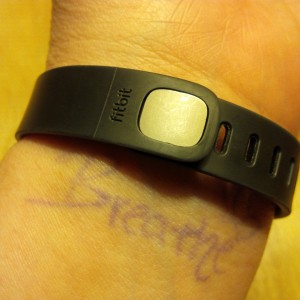The Fitbit. I wasn't convinced I really wanted one until a coworker showed me a staggering number of pounds lost on a very colorful dashboard. In her sweet Texas drawl, she explained, “It’s all here. My sleep patterns, amount of water I drank, calories eaten, and even steps taken.” One little wristband collects all kinds of data and pushes it to the user in a fun, easy to use format. The data collection is great, but what really fascinated me was what the dashboard meant to her.

Before the Fitbit, Bree didn’t understand what patterns and behaviors were the most damaging to her health. Seeing her data brought to life inspired her to overhaul her entire lifestyle. And this lesson from the Fitbit is one of data storytelling across multiple media, or "transmedia storytelling" as Bree puts it in this fantastic three-part AllAnalytics.com blog series.
Through a simple dashboard Fitbit painted a picture of someone’s reality. Hearing about Bree’s experience made me truly appreciate the impact of visuals on how we think and feel, and the art of data storytelling. Yes, all data tells a story. However, applying a meaningful narrative to the data is what makes storytelling an art. Data visualization can help you get there.
Here are some best practices you can use to build your credibility and solidify your expertise as a visual storyteller:
- Remember who the expert is
The subject matter expert’s job is to ensure the relevancy and accuracy of the data. We all know the perils of manipulating data to serve our own purposes. Act continuously as a steward for your data by omitting (or at least admitting) your own biases and assumptions. This is especially important when you construct visualizations. Sure, scaling a weight-tracking graph to make it appear someone is losing more weight than in reality sounds nice, but it is a disservice to the person relying on it.
- Research your audience
Knowing your audience will clarify who the story is for and help you establish relevancy. Jeff Bladt and Bob Filbin of DoSomething.org and Crisis Text Line point out in their HBR post the importance of focusing on data that affect their key metrics. Their goal is to get teenagers involved in volunteering. Therefore, they want to know what motivates teens to volunteer and how to recruit them. When presenting findings to employees their conversation and supporting data visualizations focus on engagement not on regression analysis and R plots. Likewise, Bree’s Fitbit dashboard isn’t going to show a molecular analysis of the nutrients she eats. Rather, it simply shows whether she has eaten too many or too little for her weight goals.
- Don’t forget context
When we start building a narrative around our data, it is easy to omit context. I still remember my college statistics professor teaching us about correlation and causation. “See, this graph shows a correlation between murder and ice cream.” The obvious lesson was ice cream does not result in murder. In the case he presented, it was a spike in crime during the summer. Data visualization is so powerful that we can easily overlook omitted information. As a storyteller, your job is to make sure you have presented the data in a fair and complete manner. If you are not sure what factors are influencing your results, you may have some more exploring to do.
- Design Matters
Data visualization reduces our information processing time. We processes visuals far faster than any other kind of information. So how you display information matters. Be selective about the amount of detail and color you use. Provide comparative charts and data when appropriate. They work - our brains are optimized to consume information visually.
- Use data visualization strategically
When my colleague first told me about the Fitbit, she hooked me by showing me one number first, her total weight loss. I couldn’t help but pay attention. Once she had my attention she walked me through what each visualization meant literally and to her overall goals. It was logical and sequential. Every visualization had meaning, which is critical to both understanding and adoption. Don’t believe me? Our average attention span is roughly 8 seconds.
- Share your story
Think back to your audience. Your audience will determine the best method of delivery. Chances are it will involve some degree of visualization, if you are smart. A well-constructed story will carry across many different channels (transmedia).
Joan Didion once said, “We tell ourselves stories in order to live...” For my colleague Bree, it is was about changing her lifestyle. Seeing her life in pictures helped her understand what she was doing well and what she needed to improve.
Storytelling is a combined ability to understand the larger context and link together threads of data in a meaningful way. Visualizations are one of the most powerful ways of deriving meaning from the data. They help us connect the dots and share our findings with those around us. So, what story will you tell?

2 Comments
Some pertinent points you raise Analise!
I love how visualizations are becoming mainstream/norm these days! As you point out, Bree seemed excited to interpret her fitbit dashboard due to the personal story it unfolded on her own data. This adoption works due to good design and context - best practices to keep in mind!
I look forward to sharing this post in future SAS Visual Analytics courses I teach. Keeping these principals in mind not only helps with transmedia storytelling but also the personal "green light" we give from what we see.
Kind Regards,
Michelle
Kind Regards,
Michelle
Thank you, Michelle! Today's technology has made it possible for us to see data in a whole new way. It is truly amazing to see all the ways we can work with and manipulate data. I think the best is yet to come. Please share your insights and stories with us as you teach SAS Visual Analytics.